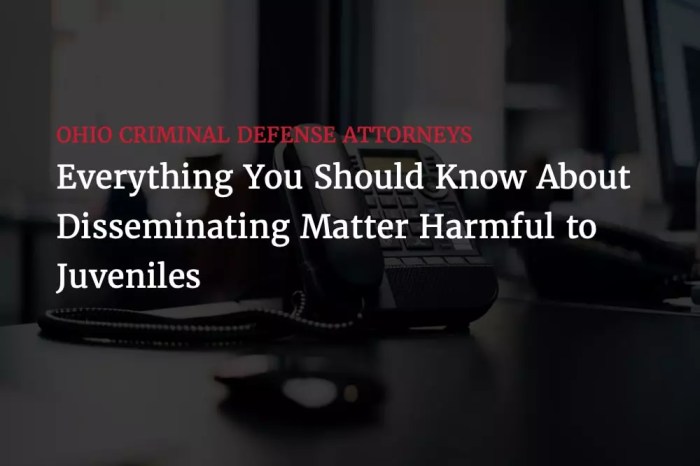What is disseminating matter harmful to juveniles examples – Exploring the multifaceted topic of disseminating matter harmful to juveniles, this comprehensive guide delves into the legal definitions, evolving interpretations, and real-world examples surrounding this pressing issue. As we navigate the complexities of protecting young minds from inappropriate content, we will examine the various types of material deemed harmful, the methods of dissemination, and the potential consequences for those who engage in such actions.
The discussion will shed light on the rationale behind classifying certain materials as harmful to juveniles, considering the impact on their development and well-being. We will also explore the challenges faced by law enforcement in combating the dissemination of such content and highlight the importance of prevention and education in safeguarding children from exposure to potentially damaging influences.
Disseminating Matter Harmful to Juveniles: Legal Definitions and Interpretations: What Is Disseminating Matter Harmful To Juveniles Examples
The legal definition of “disseminating matter harmful to juveniles” varies across jurisdictions. In the United States, for example, the federal government and each state have their own laws that define and prohibit the dissemination of such material. These laws typically focus on material that is considered to be harmful to minors, such as pornography, obscene material, and material that incites violence or hatred.
The interpretation of these laws has evolved over time. In the past, the definition of “harmful to juveniles” was often narrowly construed, and only material that was considered to be patently offensive or obscene was prohibited. However, in recent years, the definition has been expanded to include a wider range of material, including material that is harmful to minors even if it is not obscene.
There have been a number of cases in which individuals have been charged with disseminating matter harmful to juveniles. In one case, a man was convicted of distributing child pornography after he posted images of nude children on a website.
In another case, a woman was convicted of distributing obscene material after she sold a videotape of herself performing sexual acts with a minor.
Types of Matter Considered Harmful to Juveniles

The types of matter that are considered harmful to juveniles vary depending on the jurisdiction. However, some of the most common types include:
- Pornography
- Obscene material
- Material that incites violence or hatred
- Material that exploits children
These types of material are considered harmful to juveniles because they can have a negative impact on their development. Pornography, for example, can lead to unrealistic expectations about sex and relationships, and it can also contribute to sexual abuse. Obscene material can be harmful because it can desensitize children to violence and sexual abuse.
Material that incites violence or hatred can lead to prejudice and discrimination. And material that exploits children can be harmful because it can lead to abuse and exploitation.
Methods of Disseminating Matter Harmful to Juveniles

Matter harmful to juveniles can be disseminated in a variety of ways, including:
- Online platforms
- Social media
- Print publications
- Physical distribution
Online platforms are a major source of harmful material for juveniles. Children can access pornography, obscene material, and other harmful content through websites, social media, and other online platforms. Social media is a particularly dangerous platform for children because it allows them to share and access content with their friends and followers.
Print publications can also be a source of harmful material for juveniles, although they are less common than online platforms.
Consequences of Disseminating Matter Harmful to Juveniles
The consequences of disseminating matter harmful to juveniles can be severe. Individuals who are convicted of this crime may face criminal penalties, civil penalties, and damage to their reputation.
- Criminal penalties can include fines, imprisonment, or both.
- Civil penalties can include damages to the victims of the crime.
- Damage to reputation can make it difficult for individuals to get a job or housing.
The consequences of disseminating matter harmful to juveniles can also have a negative impact on the individuals’ families. The families of individuals who are convicted of this crime may experience shame, embarrassment, and financial hardship.
Prevention and Education

There are a number of things that can be done to prevent the dissemination of matter harmful to juveniles. These include:
- Education programs for children and parents
- Internet safety measures
- Law enforcement initiatives
Education programs for children and parents can help to teach children about the dangers of harmful material and how to avoid it. Internet safety measures can help to protect children from exposure to harmful material online. Law enforcement initiatives can help to identify and prosecute individuals who are disseminating harmful material to juveniles.
Prevention and education are essential to protecting children from exposure to harmful content. By working together, we can create a safer environment for our children.
Question Bank
What constitutes disseminating matter harmful to juveniles?
Disseminating matter harmful to juveniles refers to the distribution or sharing of content that is deemed inappropriate or potentially damaging to the physical, mental, or moral development of minors.
What are the different types of matter considered harmful to juveniles?
Types of matter harmful to juveniles include pornography, obscene material, content inciting violence or hatred, and material that exploits children.
What are the consequences for disseminating matter harmful to juveniles?
Consequences can include criminal penalties, civil penalties, and damage to reputation.
What are some prevention strategies for disseminating matter harmful to juveniles?
Prevention strategies include education programs for children and parents, internet safety measures, and law enforcement initiatives.